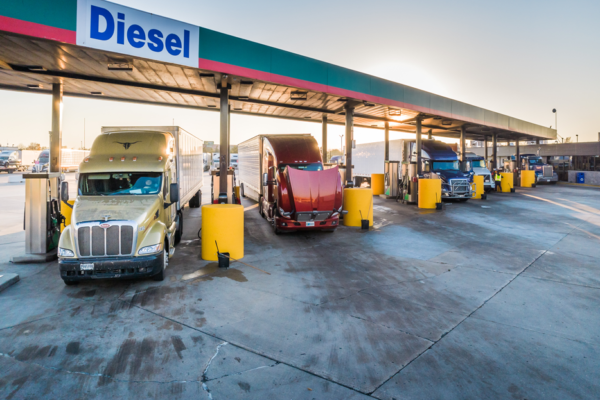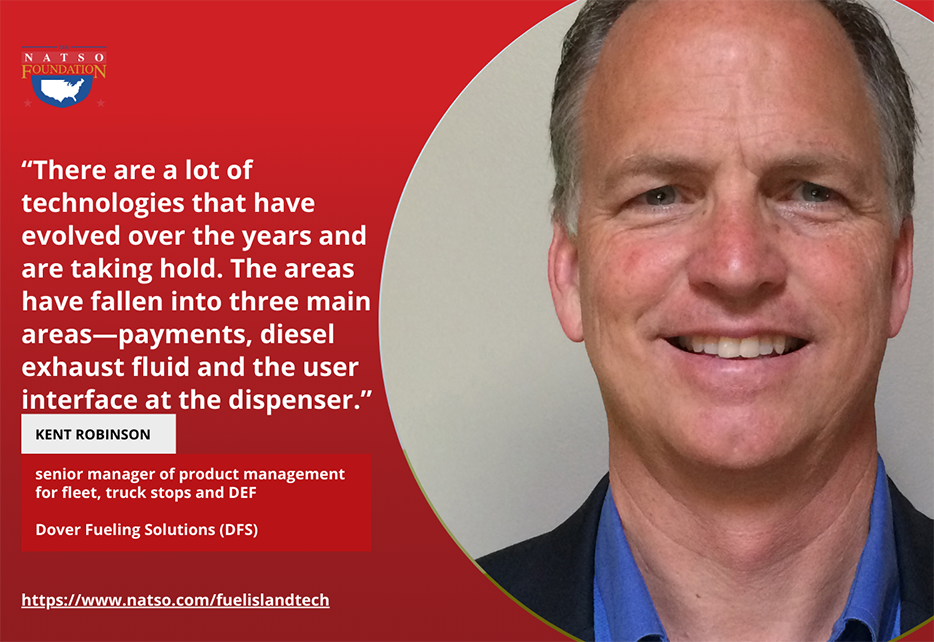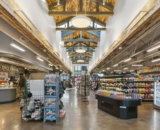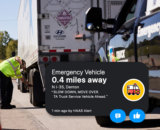Article created for the digital issue of the NATSO Foundation’s magazine
The fuel island is a necessary stop for professional truck drivers, and even minor improvements can enhance their experience, speed up transactions and influence where they stop.
Speeding Transaction Times
Professional drivers and truck stop and travel center operators share a common objective on the fuel island—to get the driver in and out as quickly as possible.
“The driver wants to get it done to take advantage of other amenities at the location or get back on the road. The station owner wants the throughput,” Robinson said.
High-flow dispensers are a crucial part of the diesel experience, but Robinson said the total transaction time is more than filling the vehicle and includes the amount of time it takes to authorize the transaction.
Diesel Dispensers with an Alphanumeric Keypad
“A lot of trucking transactions use fuel cards. They have other entries, and drivers traditionally had to walk inside and go to the fuel desk to authorize the transaction and go back to get a receipt,” Robinson said. “More and more, they want to do that transaction at the island. If I can do that right at the dispenser, I save those two trips inside and it saves a lot of time.”
Dover Fueling Solutions (DFS) has equipped its payment terminals to handle fuel cards, but Robinson said the truck stop or travel center must have a POS that will run them. “Not every single POS can handle that,” he explained.
Diesel dispensers need to have an alphanumeric keypad to handle fuel cards. “When you get into trucking fuel cards, drivers have to enter trailer numbers and IDs, so they need an alpha keypad,” Robinson said.
DFS has also added the alphanumeric keypad to its touchscreens. “If there is an alphanumeric need, a keypad pops up. It is in that normal QWERTY style we’re all used to,” Robinson said. “It also has a backspace key, which is a big deal. If you make a mistake, you don’t want to start over. It is the little things that do make a difference there.”
While the 27-inch touchscreen is offered as part of the DFS Anthem user experience, a 12-inch screen will be part of DFS’s standard offering next year. “The ability to do that interface at the island moves things quickly along, and that helps the transaction time. That makes a good experience for the driver and more throughput,” Robinson said.
Dan Riccio, product marketing manager for Gilbarco Veeder-Root, said FlexPay IV comes standard with a card reader. Contactless and alphanumeric keypads are optional. FlexPay 6, which is just launching includes a card reader, contactless reader and allows for alphanumeric functionality on the touchscreen. “We offer the hardware that would offer anything you want to do on the backcourt or forecourt,” he said, adding that pumps using FlexPay come standard with printers, but operators must ensure they’re replacing the paper often enough to meet drivers’ needs.
DFS pumps also have printers, allowing drivers to get their receipts right at the pump, whether paying with a credit or fuel card. “The printer and hardware is the same, but the receipt is different because they might need different information,” Robinson said.
Mobile Pay
Peter Rasmussen, CEO and founder of Convenience and Energy Advisors, said the next level in diesel payments will be mobile pay.
Caitlin Jensen, a spokesperson for Love’s, said the company is always working to make all fuel purchases as frictionless as possible to maximize drivers’ uptime. “This includes dispenser fuel speeds and payment processes to get drivers back on the road as quickly as possible,” she said, adding that Love’s has added payment options to its app.
Professional drivers can use Love’s Mobile Pay on the Love’s Connect app to answer prompts and pay for fuel and receive contactless, digital receipts using their mobile phones. Love’s doesn’t have receipt printers on the diesel island, so getting the receipt electronically can save drivers a trip inside.
Drivers can activate diesel pumps and pay for fuel from the cab using TA’s Pumpsmart feature in its TruckSmart app. “The feature is designed to save drivers time while fueling at TA, Petro Stopping Center or TA Express locations,” said Debi Boffa, CEO of TravelCenters of America and a NATSO board member.
TA has also added Radio Frequency Identification (RFID) technology—a wireless system comprised of tags and readers—on all diesel lanes, which provides convenience at the pump. “The tags can be placed on a truck or trailer, and readers, in the form of an antenna, are placed on our diesel canopy. This fosters a more efficient experience at the pump because the antenna continuously reads the tag during the fuel transaction, allowing the pump to turn on without a card physically being swiped at the pump,” Boffa said.
Fintech Solutions Grow
Drivers are increasingly turning to financial technology (fintech) payment methods for fuel, such as Mudflap and AtoB, Rasmussen said.
TA has recently started implementing fintech at the diesel pumps and the company is looking forward to expanding its capabilities in this space.
“Fintech cardless payment solutions include new technology that seeks to improve and automate the delivery and use of financial services, or the digital transferring of money,” Boffa said.
Non-integrated payment methods are typically processed through a tablet, which Rasmussen said can be cumbersome. “The driver has to go into get it activated and then go back in to get the receipt. That needs evolution, whether it is POS or if they connect directly with the pump,” he said.
For more on travel center fintech payments, see Fintech Companies Offer Options for Drivers and Truckstop and Travel Plaza Operators and More Consideration for Travel Center Operators Looking at Working with New Fintech Providers.
Creating Convenience with DEF
Diesel exhaust fluid has been around for a while, but some locations still don’t offer it on the fuel island, affecting the customer experience. “Truck drivers want to be able to stop at a place with bulk DEF at the island,” Robinson said. “They don’t have to get DEF every time, but when they need it, they will pick a place with DEF at the island.”
Robinson is seeing more locations adding high-speed dispensers with DEF. “We have combination models that have diesel plus DEF at the same dispenser,” he said, adding that drivers can authorize the diesel and DEF transaction at the same time if the location’s POS allows it, reducing the transaction time. “Drivers don’t have to do all of those manual entries for diesel and go back and do it again for DEF. They can do the DEF and diesel and get a common receipt.”
To help foolproof freeze prevention, Gilbarco has a heater inside the dispenser, insulation protecting the lines and temperature sensors inside the DEF cabinet. “We’ve put a lot of emphasis on freeze protection to protect equipment and ensure when the driver pulls up, that DEF will be at that dispenser,” said Joe Leonard, global product manager at Gilbarco Veeder-Root.
Enaging Drivers
The customer experience is becoming increasingly important to drivers, and Robinson said screen displays are providing new opportunities for locations to offer promotions, useful information such as the weather and highlight all the services the location offers. “We put our first ones in this past year at a truck stop. It is picking up, and we’ve had really good results. They’ve increased their throughput of sales,” he said. “It is proving that with this digital impact, we can change the buying experience and make it easier for the trucker as well.”
The displays create a digital billboard right at the island, Robinson explained. “They have a way of promoting that and letting the truckers know what else they have available and promote specials,” he said. “When people thought about the technology originally, they thought of it as a consumer technology, but when you sit back and think about it, there is more marketing opportunities for the truck driver,” Robinson said.
Operators can also add DX Market to their DFS pumps, allowing drivers to order food while they’re fueling. “They can sit there at the dispenser and place their order for food. They go inside and can pick it up. We’ve moved that food-ordering kiosk into the dispenser,” Robinson said.
Rasmussen said operators should consider adding mobile ordering, even if it isn’t through the pump. “It is easy and drivers aren’t standing in lines,” he said. “You don’t even need to have an app for it.”
Operators can push their menu through a common order aggregator. “They can create a first-party ordering experience. They can also push to Uber, Door Dash, Grubhub, Postmates or Google,” Rasmussen said.
Jensen said the Love’s app is helping drivers make better use of their time at the pump. “While fueling, drivers can check in and pay for showers to avoid standing in line at the diesel desk,” she said.
Eliminating Fueling Issues
Other improvements are invisible to the customer but still improve the driver experience. Stephen Coppola, director of product management for Veeder-Root, said the Veeder-Root HydrX Fuel Conditioning System provides continuous water removal to keep fuel clean and dry at the bottom of the tank and prohibit microbial growth, which ultimately improves the driver experience.
“It goes unnoticed by the truckers,” Coppola said.
Adding Alternative Fuels
The number of fuels used in trucking is expected to increase, which will affect the fueling experience at truck stops and travel centers in the future. “We will probably move to multi-fueling facilities,” Robinson said. “Diesel has been one-size-fits-all, but we’ll probably move to a world where equipment becomes more application-specific.”
Equipment hauling heavy loads and traversing mountains will likely rely on diesel, but other applications may be better suited to electric vehicles or hydrogen, Robinson explained. “Truck stops will have to do all of those things,” he said, adding that new fuels will require new infrastructure. “If you are doing a new build and have room, you can create a layout for it.”
While many alternative fuels are still years away, biodiesel is readily available today. Coppola said Veeder-Root’s Biofuel Blending System, in partnership with Total Meter Services Inc., allows operators to blend biofuels on site with automated in-line blending, giving them more control.
// This article was created for Stop Watch magazine, the magazine of the NATSO Foundation. The NATSO Foundation is the research, education and public outreach subsidiary of NATSO, Inc. The NATSO Foundation provides programs and products to strengthen travel plazas’ ability to meet the traveling public's needs through improved operational performance and business planning. Visit www.natsofoundation.org for more information. (Donate to the NATSO Foundation here.)
Subscribe to Updates
NATSO provides a breadth of information created to strengthen travel plazas’ ability to meet the needs of the travelling public in an age of disruption. This includes knowledge filled blog posts, articles and publications. If you would like to receive a digest of blog post and articles directly in your inbox, please provide your name, email and the frequency of the updates you want to receive the email digest.













